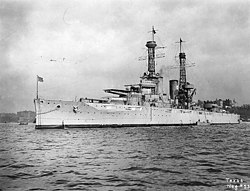USS Texas (BB-35)
|
||||||||||||||||||||
|
||||||||||||||||||||
|
||||||||||||||||||||
|
||||||||||||||||||||
The USS Texas is a decommissioned battleship of the United States Navy and is now a museum ship. According to the practice at the time, it was named as a "capital ship" after a US state. As the only sister ship of the USS New York , she belonged to the New York class .
history


Planning and construction
Because the Royal Navy had increased the main caliber of its battleships from 30.5 cm to 34.4 cm in the Orion class , the US Navy decided that the New York class following the Wyoming class should be equipped with a stronger main caliber. Since they wanted to outdo the British, they chose the 35.6 cm caliber. The number of cannons was initially planned to be 12, but that would have resulted in an increase in size to 30,000 t. The construction costs would also have risen considerably. So one stuck to the layout scheme, which essentially corresponded to that of the Delaware class .
The cost of building both ships was approximately $ 2.19 million.
First World War
In January 1918, when the United States entered the First World War , she was detached to the British Grand Fleet . From 1925 to 1927 it was rebuilt in Norfolk (enlargement of the superstructure, removal of the old lattice masts, middle artillery one deck higher, replacement and reduction of the old boilers with new, space-saving models).
Time between the world wars
After the First World War, the USS Texas was temporarily stationed at the Guantanamo Bay Naval Base in Cuba, where it was used for various tests. Among other things, an aircraft took off from the USS Texas on March 9, 1919 (according to other sources on March 10) for the first time from a ship of the US Navy. In the absence of a suitable aircraft type of its own, a British Sopwith F.1 Camel was used, which was piloted by Lieutenant Commander Edward O. McDonnell .
Second World War
In November 1942 she supported the Allied landing in North Africa . On June 6, 1944 , it served as artillery support for the Allied troops off the coast of Normandy . In August 1944 she was again assigned to artillery support during the Allied landings in southern France . To increase the range of the artillery, it was partially flooded in order to achieve an even higher vertical angle of attack by means of a (low) list. From February 1945 she took part in the landing operations on Iwo Jima and Okinawa . After the war ended, it was transferred to the State of Texas in 1948 and converted into a museum ship in the San Jacinto Battleground State Historic Site near La Porte .
today
In December 1976, the ship was granted National Historic Landmark status and was listed as a structure on the National Register of Historic Places . Meanwhile the further preservation of the Texas is endangered. Up to 300 tons of water penetrate the ship every day, which greatly accelerates corrosion. In addition, there are regular heavy storms due to the berth in Hurricane Alley .
Web links
- Battleship Texas State Historic Site (Engl.)
- Unofficial Homepage (Engl.)
- USS Texas at navsource.org (Eng.)
- Picture gallery
- Images of the USS Texas
- Saving the Battleship Texas
Individual evidence
-
↑ USS TEXAS on the National Register of Historic Places , accessed February 24, 2020.
Listing of National Historic Landmarks by State: Texas. National Park Service , accessed February 23, 2020.
Coordinates: 29 ° 45 ′ 23 " N , 95 ° 5 ′ 21.7" W.
